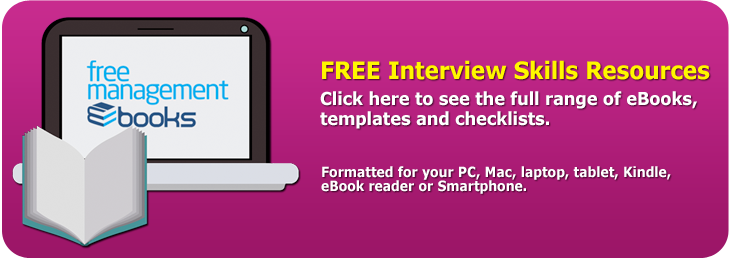Matching Competencies to Role Responsibilities Example
To illustrate how you make a comparison between your own competencies and that of the role we will use the top four competencies from the previous example. These are:
1) Customer Focused
2) Strategic Thinking
3) Leadership
4) Interpersonal Communications
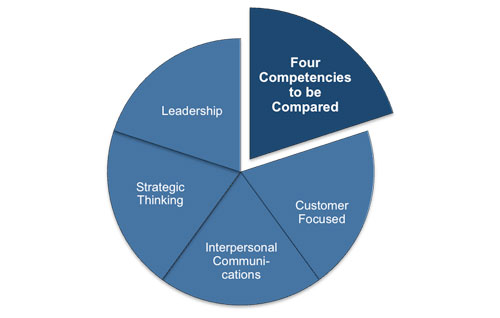 |
For each competency the common management framework definition is used and displayed at the top of each competency table.
The left-hand column shows the required management behaviors.
The middle and right-hand columns provide examples of how Sam has displayed this competency through his behavior at:
o Work (middle); and
o Different social situations (right).
This method of comparison enables you to quickly identify whether your behavior matches that required. Any gaps that occur mean that you will need to draw on outside activities.
The following four tables illustrate how Sam made his comparisons and identified his competency gaps for the role of marketing manager.
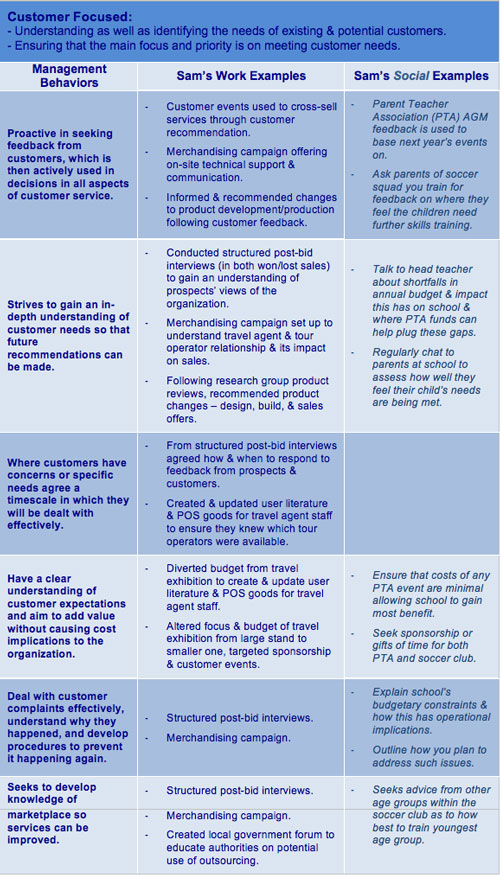 |
During the management assessment Sam can be confident that he has displayed the customer-focused behaviors required of the role. But he will have to ensure that his verbal answers and behaviors in any interview exercises portray the language of a strategically focused individual rather than that of his current tactical level.
The second competency that is required is strategic thinking and for Sam to be successful he must display this at the correct level.
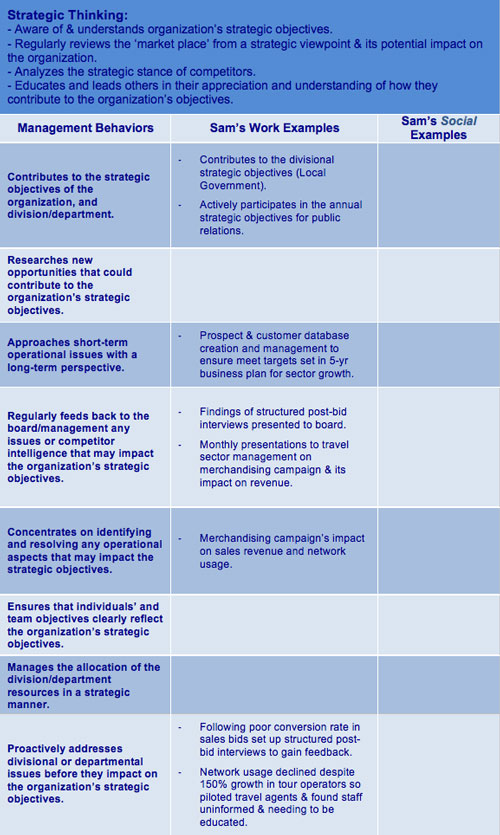 |
After completing this table it is quite clear that Sam lacks the necessary 'strategic thinking' behaviors required by the role and that his behavior is below that of a marketing manager. His examples also lack evidence of Internet marketing and its strategic use and importance.
This is one area that his social activities do not offer any assistance at the management level. His behaviors in both work and social activities show considerable awareness of strategies but not its formation.
For the role of marketing manager the competency of leadership is one to be expected in the top four and Sam's behaviors will need to clearly and consistently portray his strength in this area.
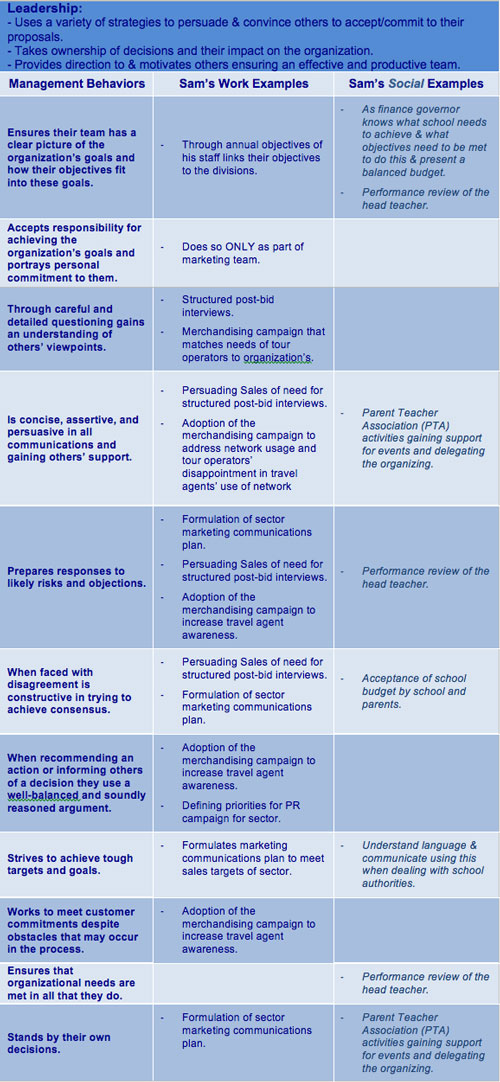 |
This table shows that Sam has established leadership behaviors. He has taken on social roles to acquire those behaviors he is unable to develop at work.
1) Parent governor (2nd Term) and Chair of Finance Committee
2) Chair of school Parent Teacher Association
3) Responsible for setting and reviewing (in connection with selected authority representative) the head teacher's annual performance against the School Development Plan.
4) Qualified as one of the soccer coaches for local club.
5) Responsible for first aid within the age group.
These examples show that he actively plans his personal development to advance his KSA's (Knowledge, Skills, and Attitudes). To be successful he will need to ensure that his behaviors during a management assessment display the strategic focus of the role, not his current tactical-level behaviors. For example:
1) Show the ability to create the marketing plan in its entirety not just the marketing communications plan.
2) Display the capability to manage a team over multiple sites, using a variety of communication tools.
The fourth of the competencies to be used in this comparison is 'Interpersonal Communications.' From the table below it is evident that Sam operates at the appropriate level for a marketing manager in this competency. Much of this has been done as part of his own professional development with the AMA and working towards a doctoral membership.
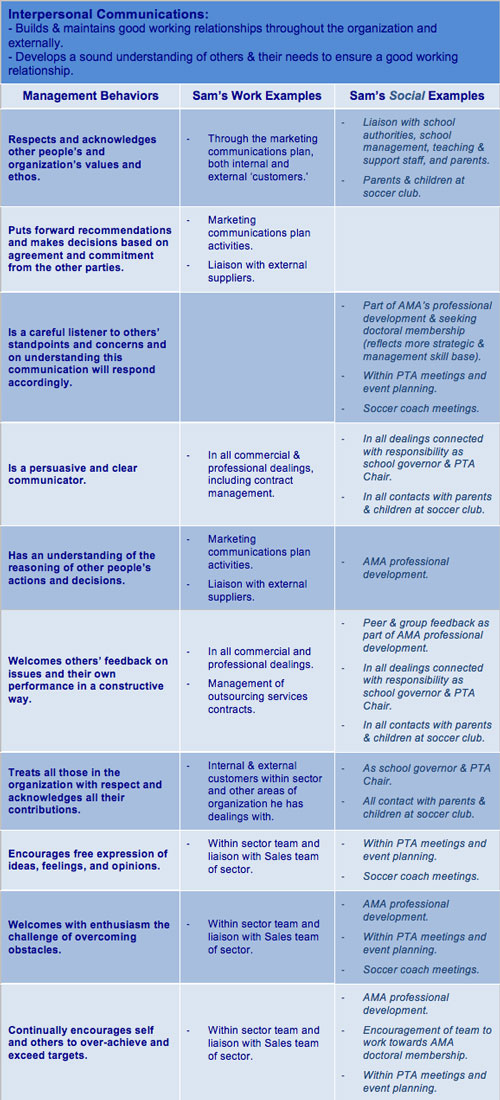 |
Sam will also have to demonstrate that he has the right level of skill in managing budgets as well as defining objectives from the organization's public relations (PR). He has the knowledge from his AMA involvement but must ensure his behaviors and responses to questions reflect a strategic rather than tactical approach to tasks. A simple and effective way to understand the difference is to observe how the current occupant of the role or other managers of equivalent authority and responsibilities conduct themselves.
Overall, this comparison exercise of the four main competencies required for the marketing manager's role shows that Sam (whilst knowledgeable and capable of performing the role) is lacking wider management experience. However, his personal ambition is evident and could be enough to get him to the interview stage of the recruiting process.
This example demonstrates how a comparison of competencies can be made and how gaps within an individual's competencies can be identified. Using the descriptions of the behaviors associated with particular competencies makes it possible to determine the most effective way to fill any gaps using either work or non-work examples.
A successful management career is based on a series of job moves with each one bringing more responsibility and authority. In order to make these moves you will need to develop a long-term career plan in which each of the upward steps is big enough to be worthwhile whilst still being achievable.
Each move will involve some sort of management assessment that may be internal or external. The interview preparation discussed in this eBook is only part of a much bigger picture because there is no point in preparing well for the 'wrong' interview. It is far more beneficial in the long run to have a proper career plan and to only apply for jobs that further that plan than it is to apply for jobs that offer a better package but represent a backward step or a dead-end career-wise.
It should go without saying that you need to understand any organization that you are considering going to work for. You can get all of the information you need from their website, annual reports, financial statements, press releases, and social media.
All of this information can be brought together to help you understand how the organization sees itself, what it considers important, and where it is going. Re-reading the job ad in the light of this information can help you to see the role in a wider context. This is important because you need to be sure that it matches your expectations and desires.
You should also develop a good understanding of the market. The easiest way to do this is to read the industry press to gain an understanding of the main topics of discussion and concern. It can also be useful to look at how the national press describes the market and its main players. Although we are using terms like 'market' and 'industry' this still applies to the nonprofit sector because even charities and NGOs are subject to external influences and operate in a market where funding takes the place of profits.
Officially published information can be crosschecked with what is being said in blogs and social media comments. These sources can sometimes be at odds with more established media but tend to be ahead of the curve if something disruptive or controversial is in the offing.
The knowledge that you can gain from this research will prove invaluable in making a decision about whether a particular organization is right for you in terms of the culture, values, and direction.
You may also be interested in:
Management Interview Preparation | Preliminary Interviews | Using a Recruitment Agency | Understanding the Role Description | Matching Competencies to Role Responsibilities | Matching Competencies Example.

